A Program for Preventing Overweight and Obesity in the United States
VerifiedAdded on 2022/09/30
|7
|1577
|84
Report
AI Summary
This report addresses the critical issue of overweight and obesity in the United States, highlighting its prevalence, particularly among middle-aged adults, and its associated health and economic consequences. The author proposes a comprehensive program to combat this health crisis, focusing on strategies to promote nutrition and physical activity. The program's key components include deploying dietitians in health centers and community settings, collaborating with the government to regulate fast food and food additives, promoting physical activity through mobile applications and gym incentives, advocating for proper child care and education, and establishing community education centers. The report emphasizes the importance of government cooperation and offers a multifaceted approach to prevent the progression of overweight and obesity in the US, with the ultimate goal of improving public health outcomes. The program aims to provide scientifically sound information, encourage healthy lifestyles, and address the root causes of obesity through a variety of channels, including mass media, community outreach, and clinical services. The report highlights the economic and health burden of obesity and presents a detailed plan to mitigate these impacts through evidence-based interventions.
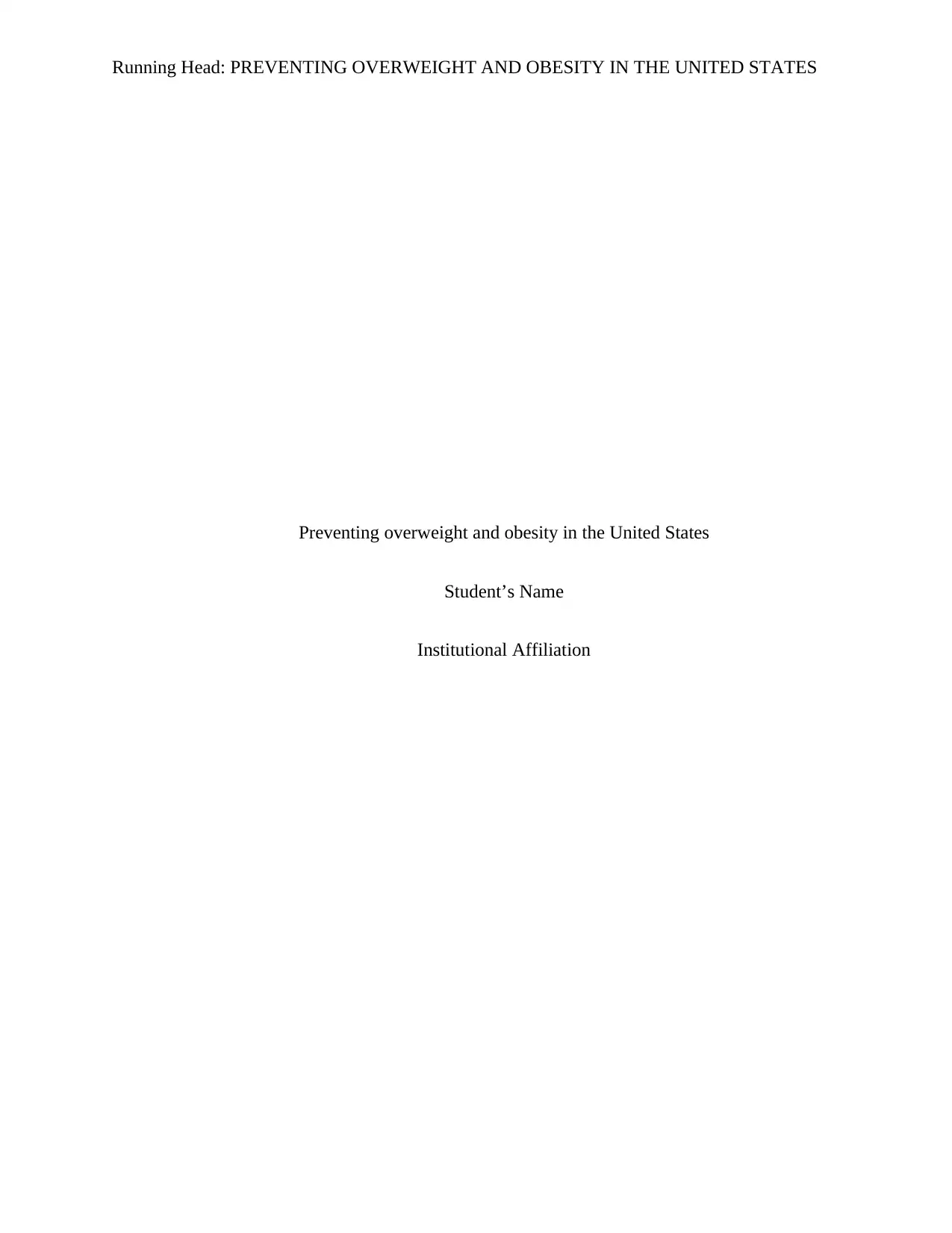
Running Head: PREVENTING OVERWEIGHT AND OBESITY IN THE UNITED STATES
Preventing overweight and obesity in the United States
Student’s Name
Institutional Affiliation
Preventing overweight and obesity in the United States
Student’s Name
Institutional Affiliation
Paraphrase This Document
Need a fresh take? Get an instant paraphrase of this document with our AI Paraphraser
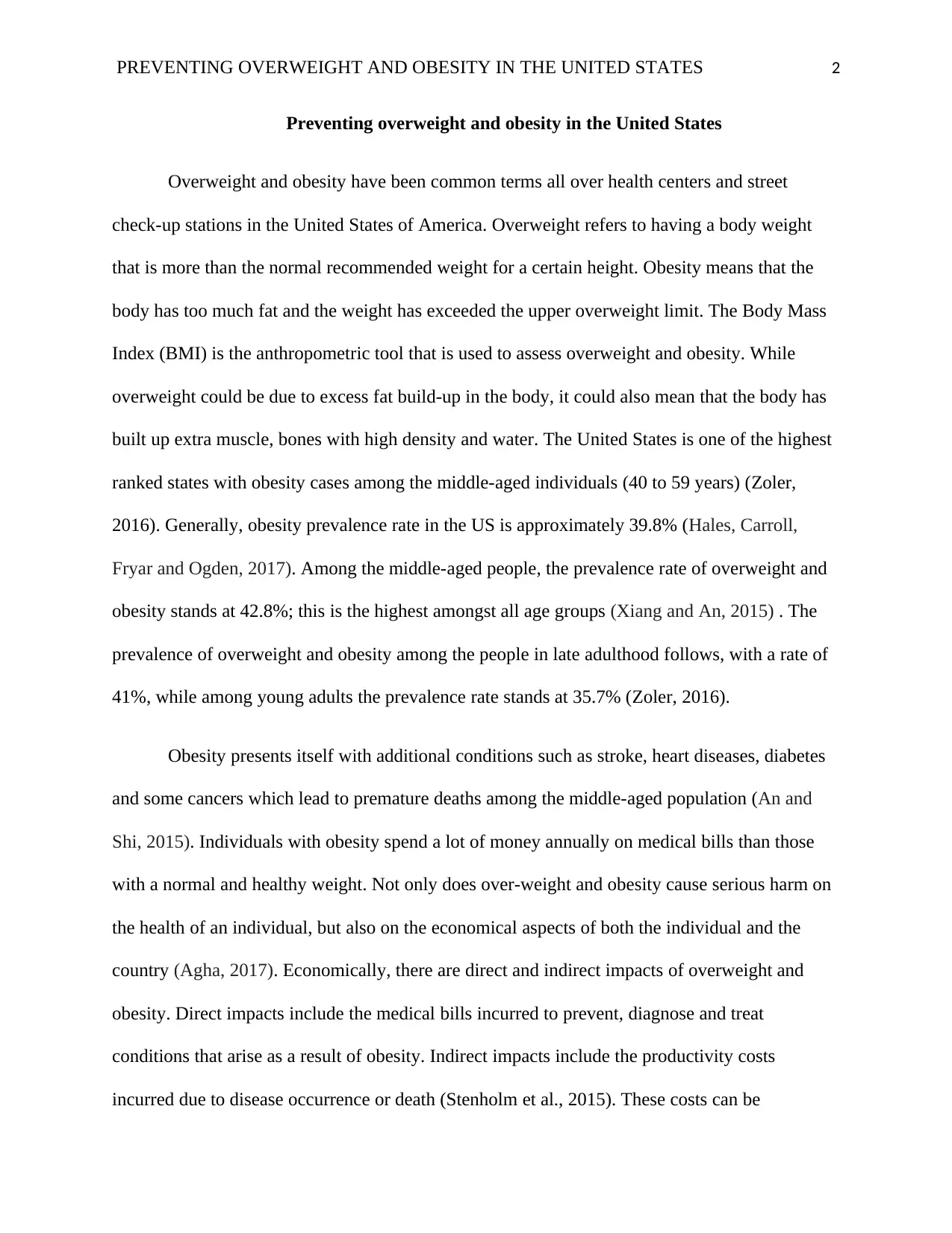
PREVENTING OVERWEIGHT AND OBESITY IN THE UNITED STATES 2
Preventing overweight and obesity in the United States
Overweight and obesity have been common terms all over health centers and street
check-up stations in the United States of America. Overweight refers to having a body weight
that is more than the normal recommended weight for a certain height. Obesity means that the
body has too much fat and the weight has exceeded the upper overweight limit. The Body Mass
Index (BMI) is the anthropometric tool that is used to assess overweight and obesity. While
overweight could be due to excess fat build-up in the body, it could also mean that the body has
built up extra muscle, bones with high density and water. The United States is one of the highest
ranked states with obesity cases among the middle-aged individuals (40 to 59 years) (Zoler,
2016). Generally, obesity prevalence rate in the US is approximately 39.8% (Hales, Carroll,
Fryar and Ogden, 2017). Among the middle-aged people, the prevalence rate of overweight and
obesity stands at 42.8%; this is the highest amongst all age groups (Xiang and An, 2015) . The
prevalence of overweight and obesity among the people in late adulthood follows, with a rate of
41%, while among young adults the prevalence rate stands at 35.7% (Zoler, 2016).
Obesity presents itself with additional conditions such as stroke, heart diseases, diabetes
and some cancers which lead to premature deaths among the middle-aged population (An and
Shi, 2015). Individuals with obesity spend a lot of money annually on medical bills than those
with a normal and healthy weight. Not only does over-weight and obesity cause serious harm on
the health of an individual, but also on the economical aspects of both the individual and the
country (Agha, 2017). Economically, there are direct and indirect impacts of overweight and
obesity. Direct impacts include the medical bills incurred to prevent, diagnose and treat
conditions that arise as a result of obesity. Indirect impacts include the productivity costs
incurred due to disease occurrence or death (Stenholm et al., 2015). These costs can be
Preventing overweight and obesity in the United States
Overweight and obesity have been common terms all over health centers and street
check-up stations in the United States of America. Overweight refers to having a body weight
that is more than the normal recommended weight for a certain height. Obesity means that the
body has too much fat and the weight has exceeded the upper overweight limit. The Body Mass
Index (BMI) is the anthropometric tool that is used to assess overweight and obesity. While
overweight could be due to excess fat build-up in the body, it could also mean that the body has
built up extra muscle, bones with high density and water. The United States is one of the highest
ranked states with obesity cases among the middle-aged individuals (40 to 59 years) (Zoler,
2016). Generally, obesity prevalence rate in the US is approximately 39.8% (Hales, Carroll,
Fryar and Ogden, 2017). Among the middle-aged people, the prevalence rate of overweight and
obesity stands at 42.8%; this is the highest amongst all age groups (Xiang and An, 2015) . The
prevalence of overweight and obesity among the people in late adulthood follows, with a rate of
41%, while among young adults the prevalence rate stands at 35.7% (Zoler, 2016).
Obesity presents itself with additional conditions such as stroke, heart diseases, diabetes
and some cancers which lead to premature deaths among the middle-aged population (An and
Shi, 2015). Individuals with obesity spend a lot of money annually on medical bills than those
with a normal and healthy weight. Not only does over-weight and obesity cause serious harm on
the health of an individual, but also on the economical aspects of both the individual and the
country (Agha, 2017). Economically, there are direct and indirect impacts of overweight and
obesity. Direct impacts include the medical bills incurred to prevent, diagnose and treat
conditions that arise as a result of obesity. Indirect impacts include the productivity costs
incurred due to disease occurrence or death (Stenholm et al., 2015). These costs can be
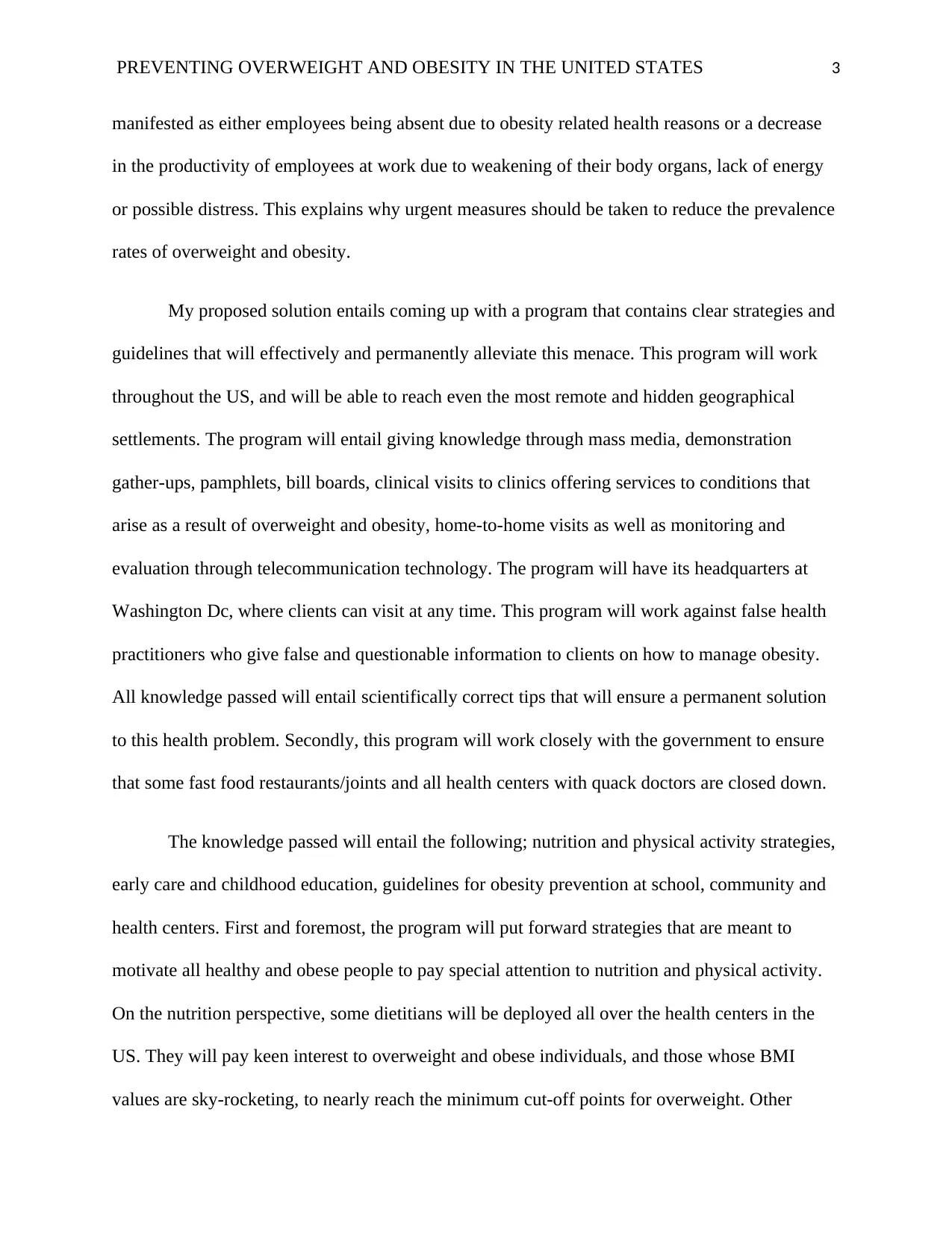
PREVENTING OVERWEIGHT AND OBESITY IN THE UNITED STATES 3
manifested as either employees being absent due to obesity related health reasons or a decrease
in the productivity of employees at work due to weakening of their body organs, lack of energy
or possible distress. This explains why urgent measures should be taken to reduce the prevalence
rates of overweight and obesity.
My proposed solution entails coming up with a program that contains clear strategies and
guidelines that will effectively and permanently alleviate this menace. This program will work
throughout the US, and will be able to reach even the most remote and hidden geographical
settlements. The program will entail giving knowledge through mass media, demonstration
gather-ups, pamphlets, bill boards, clinical visits to clinics offering services to conditions that
arise as a result of overweight and obesity, home-to-home visits as well as monitoring and
evaluation through telecommunication technology. The program will have its headquarters at
Washington Dc, where clients can visit at any time. This program will work against false health
practitioners who give false and questionable information to clients on how to manage obesity.
All knowledge passed will entail scientifically correct tips that will ensure a permanent solution
to this health problem. Secondly, this program will work closely with the government to ensure
that some fast food restaurants/joints and all health centers with quack doctors are closed down.
The knowledge passed will entail the following; nutrition and physical activity strategies,
early care and childhood education, guidelines for obesity prevention at school, community and
health centers. First and foremost, the program will put forward strategies that are meant to
motivate all healthy and obese people to pay special attention to nutrition and physical activity.
On the nutrition perspective, some dietitians will be deployed all over the health centers in the
US. They will pay keen interest to overweight and obese individuals, and those whose BMI
values are sky-rocketing, to nearly reach the minimum cut-off points for overweight. Other
manifested as either employees being absent due to obesity related health reasons or a decrease
in the productivity of employees at work due to weakening of their body organs, lack of energy
or possible distress. This explains why urgent measures should be taken to reduce the prevalence
rates of overweight and obesity.
My proposed solution entails coming up with a program that contains clear strategies and
guidelines that will effectively and permanently alleviate this menace. This program will work
throughout the US, and will be able to reach even the most remote and hidden geographical
settlements. The program will entail giving knowledge through mass media, demonstration
gather-ups, pamphlets, bill boards, clinical visits to clinics offering services to conditions that
arise as a result of overweight and obesity, home-to-home visits as well as monitoring and
evaluation through telecommunication technology. The program will have its headquarters at
Washington Dc, where clients can visit at any time. This program will work against false health
practitioners who give false and questionable information to clients on how to manage obesity.
All knowledge passed will entail scientifically correct tips that will ensure a permanent solution
to this health problem. Secondly, this program will work closely with the government to ensure
that some fast food restaurants/joints and all health centers with quack doctors are closed down.
The knowledge passed will entail the following; nutrition and physical activity strategies,
early care and childhood education, guidelines for obesity prevention at school, community and
health centers. First and foremost, the program will put forward strategies that are meant to
motivate all healthy and obese people to pay special attention to nutrition and physical activity.
On the nutrition perspective, some dietitians will be deployed all over the health centers in the
US. They will pay keen interest to overweight and obese individuals, and those whose BMI
values are sky-rocketing, to nearly reach the minimum cut-off points for overweight. Other
⊘ This is a preview!⊘
Do you want full access?
Subscribe today to unlock all pages.

Trusted by 1+ million students worldwide
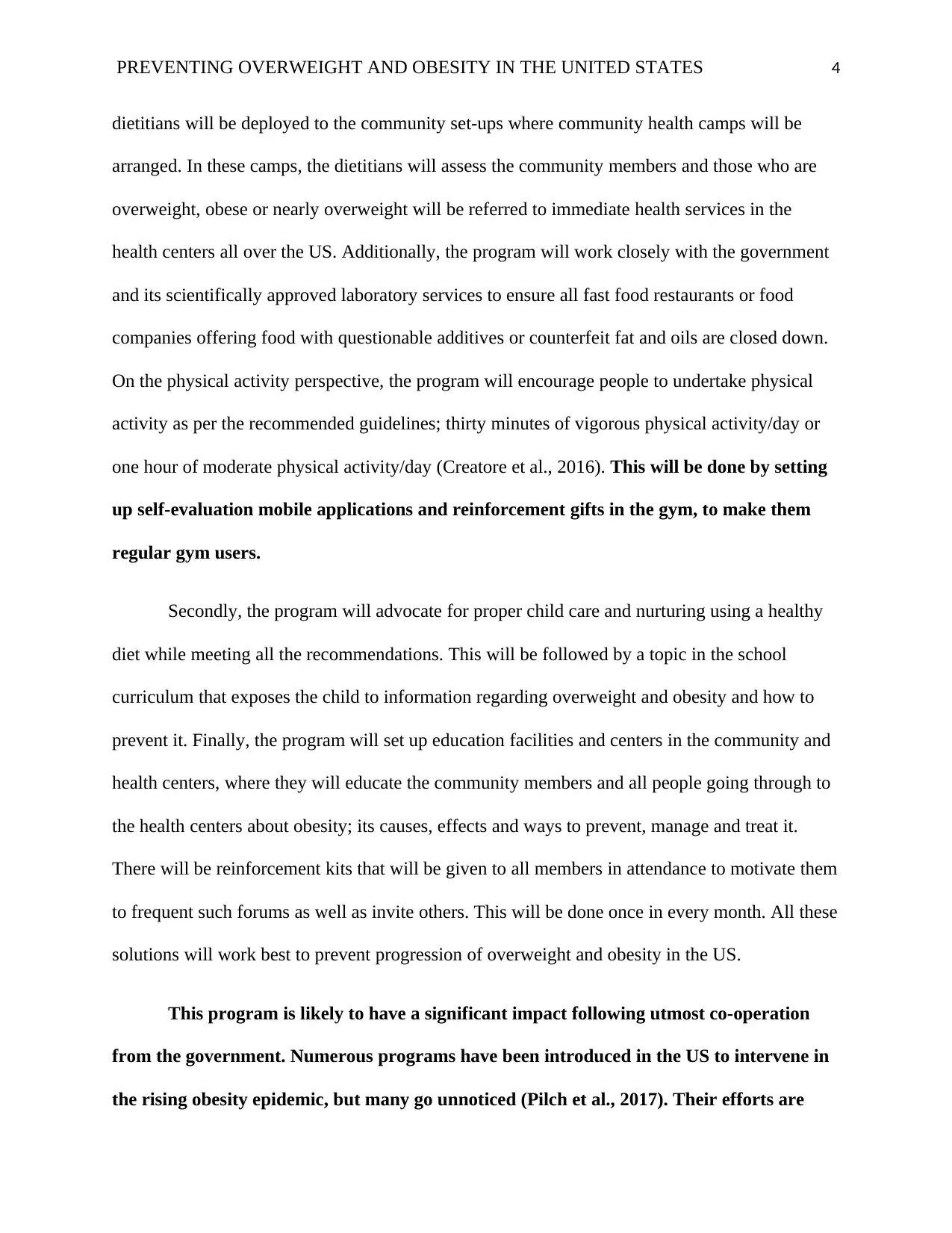
PREVENTING OVERWEIGHT AND OBESITY IN THE UNITED STATES 4
dietitians will be deployed to the community set-ups where community health camps will be
arranged. In these camps, the dietitians will assess the community members and those who are
overweight, obese or nearly overweight will be referred to immediate health services in the
health centers all over the US. Additionally, the program will work closely with the government
and its scientifically approved laboratory services to ensure all fast food restaurants or food
companies offering food with questionable additives or counterfeit fat and oils are closed down.
On the physical activity perspective, the program will encourage people to undertake physical
activity as per the recommended guidelines; thirty minutes of vigorous physical activity/day or
one hour of moderate physical activity/day (Creatore et al., 2016). This will be done by setting
up self-evaluation mobile applications and reinforcement gifts in the gym, to make them
regular gym users.
Secondly, the program will advocate for proper child care and nurturing using a healthy
diet while meeting all the recommendations. This will be followed by a topic in the school
curriculum that exposes the child to information regarding overweight and obesity and how to
prevent it. Finally, the program will set up education facilities and centers in the community and
health centers, where they will educate the community members and all people going through to
the health centers about obesity; its causes, effects and ways to prevent, manage and treat it.
There will be reinforcement kits that will be given to all members in attendance to motivate them
to frequent such forums as well as invite others. This will be done once in every month. All these
solutions will work best to prevent progression of overweight and obesity in the US.
This program is likely to have a significant impact following utmost co-operation
from the government. Numerous programs have been introduced in the US to intervene in
the rising obesity epidemic, but many go unnoticed (Pilch et al., 2017). Their efforts are
dietitians will be deployed to the community set-ups where community health camps will be
arranged. In these camps, the dietitians will assess the community members and those who are
overweight, obese or nearly overweight will be referred to immediate health services in the
health centers all over the US. Additionally, the program will work closely with the government
and its scientifically approved laboratory services to ensure all fast food restaurants or food
companies offering food with questionable additives or counterfeit fat and oils are closed down.
On the physical activity perspective, the program will encourage people to undertake physical
activity as per the recommended guidelines; thirty minutes of vigorous physical activity/day or
one hour of moderate physical activity/day (Creatore et al., 2016). This will be done by setting
up self-evaluation mobile applications and reinforcement gifts in the gym, to make them
regular gym users.
Secondly, the program will advocate for proper child care and nurturing using a healthy
diet while meeting all the recommendations. This will be followed by a topic in the school
curriculum that exposes the child to information regarding overweight and obesity and how to
prevent it. Finally, the program will set up education facilities and centers in the community and
health centers, where they will educate the community members and all people going through to
the health centers about obesity; its causes, effects and ways to prevent, manage and treat it.
There will be reinforcement kits that will be given to all members in attendance to motivate them
to frequent such forums as well as invite others. This will be done once in every month. All these
solutions will work best to prevent progression of overweight and obesity in the US.
This program is likely to have a significant impact following utmost co-operation
from the government. Numerous programs have been introduced in the US to intervene in
the rising obesity epidemic, but many go unnoticed (Pilch et al., 2017). Their efforts are
Paraphrase This Document
Need a fresh take? Get an instant paraphrase of this document with our AI Paraphraser
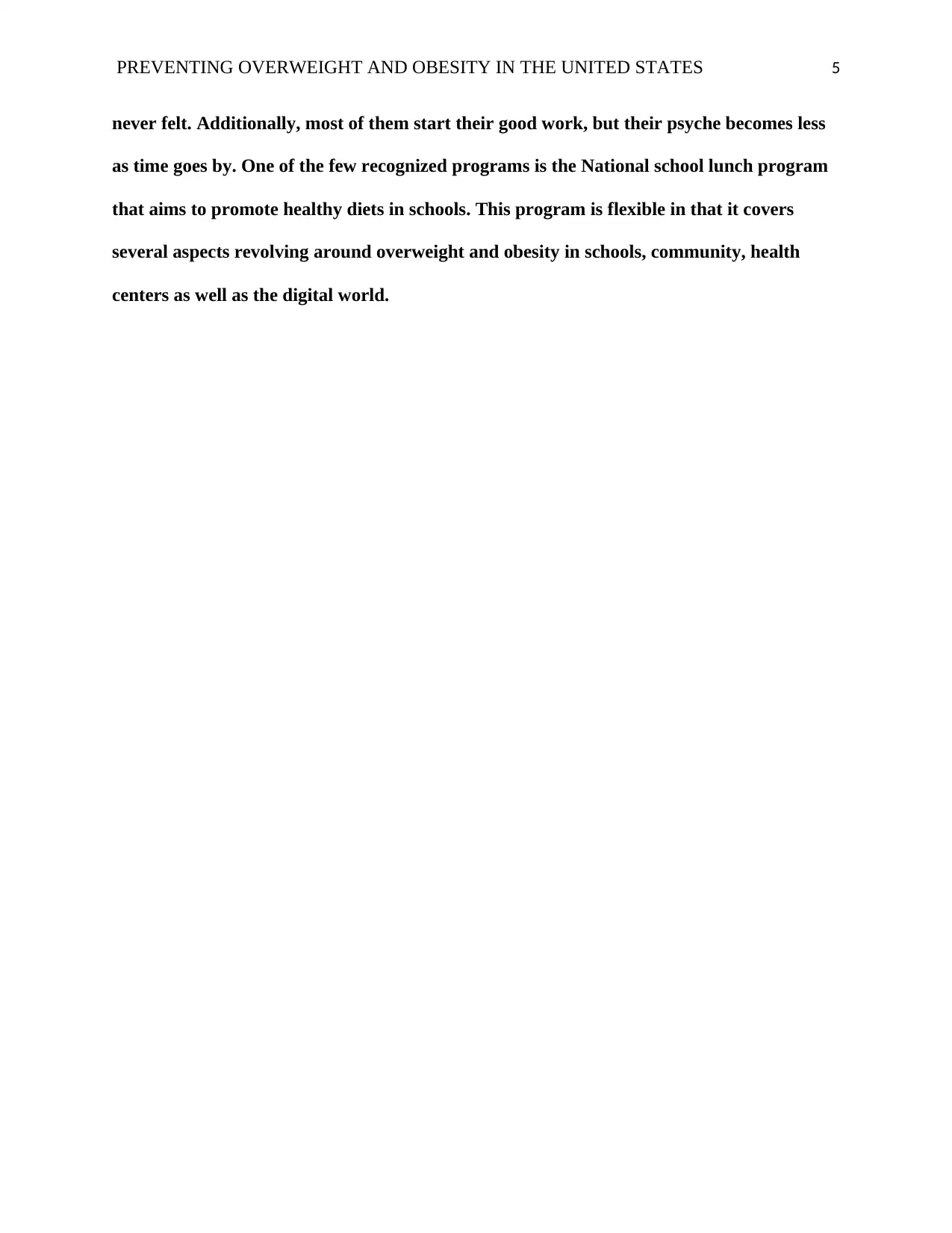
PREVENTING OVERWEIGHT AND OBESITY IN THE UNITED STATES 5
never felt. Additionally, most of them start their good work, but their psyche becomes less
as time goes by. One of the few recognized programs is the National school lunch program
that aims to promote healthy diets in schools. This program is flexible in that it covers
several aspects revolving around overweight and obesity in schools, community, health
centers as well as the digital world.
never felt. Additionally, most of them start their good work, but their psyche becomes less
as time goes by. One of the few recognized programs is the National school lunch program
that aims to promote healthy diets in schools. This program is flexible in that it covers
several aspects revolving around overweight and obesity in schools, community, health
centers as well as the digital world.
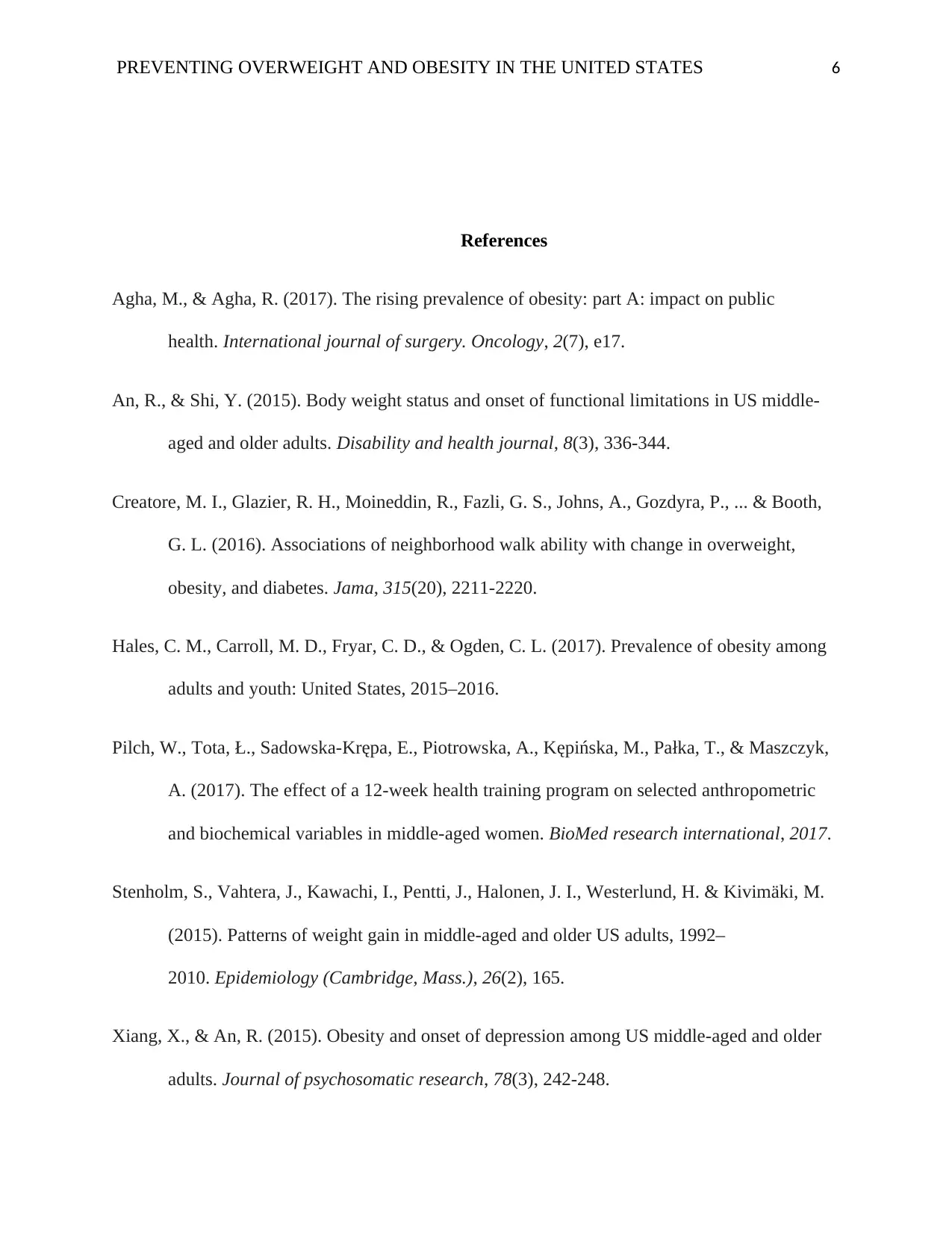
PREVENTING OVERWEIGHT AND OBESITY IN THE UNITED STATES 6
References
Agha, M., & Agha, R. (2017). The rising prevalence of obesity: part A: impact on public
health. International journal of surgery. Oncology, 2(7), e17.
An, R., & Shi, Y. (2015). Body weight status and onset of functional limitations in US middle-
aged and older adults. Disability and health journal, 8(3), 336-344.
Creatore, M. I., Glazier, R. H., Moineddin, R., Fazli, G. S., Johns, A., Gozdyra, P., ... & Booth,
G. L. (2016). Associations of neighborhood walk ability with change in overweight,
obesity, and diabetes. Jama, 315(20), 2211-2220.
Hales, C. M., Carroll, M. D., Fryar, C. D., & Ogden, C. L. (2017). Prevalence of obesity among
adults and youth: United States, 2015–2016.
Pilch, W., Tota, Ł., Sadowska-Krępa, E., Piotrowska, A., Kępińska, M., Pałka, T., & Maszczyk,
A. (2017). The effect of a 12-week health training program on selected anthropometric
and biochemical variables in middle-aged women. BioMed research international, 2017.
Stenholm, S., Vahtera, J., Kawachi, I., Pentti, J., Halonen, J. I., Westerlund, H. & Kivimäki, M.
(2015). Patterns of weight gain in middle-aged and older US adults, 1992–
2010. Epidemiology (Cambridge, Mass.), 26(2), 165.
Xiang, X., & An, R. (2015). Obesity and onset of depression among US middle-aged and older
adults. Journal of psychosomatic research, 78(3), 242-248.
References
Agha, M., & Agha, R. (2017). The rising prevalence of obesity: part A: impact on public
health. International journal of surgery. Oncology, 2(7), e17.
An, R., & Shi, Y. (2015). Body weight status and onset of functional limitations in US middle-
aged and older adults. Disability and health journal, 8(3), 336-344.
Creatore, M. I., Glazier, R. H., Moineddin, R., Fazli, G. S., Johns, A., Gozdyra, P., ... & Booth,
G. L. (2016). Associations of neighborhood walk ability with change in overweight,
obesity, and diabetes. Jama, 315(20), 2211-2220.
Hales, C. M., Carroll, M. D., Fryar, C. D., & Ogden, C. L. (2017). Prevalence of obesity among
adults and youth: United States, 2015–2016.
Pilch, W., Tota, Ł., Sadowska-Krępa, E., Piotrowska, A., Kępińska, M., Pałka, T., & Maszczyk,
A. (2017). The effect of a 12-week health training program on selected anthropometric
and biochemical variables in middle-aged women. BioMed research international, 2017.
Stenholm, S., Vahtera, J., Kawachi, I., Pentti, J., Halonen, J. I., Westerlund, H. & Kivimäki, M.
(2015). Patterns of weight gain in middle-aged and older US adults, 1992–
2010. Epidemiology (Cambridge, Mass.), 26(2), 165.
Xiang, X., & An, R. (2015). Obesity and onset of depression among US middle-aged and older
adults. Journal of psychosomatic research, 78(3), 242-248.
⊘ This is a preview!⊘
Do you want full access?
Subscribe today to unlock all pages.

Trusted by 1+ million students worldwide
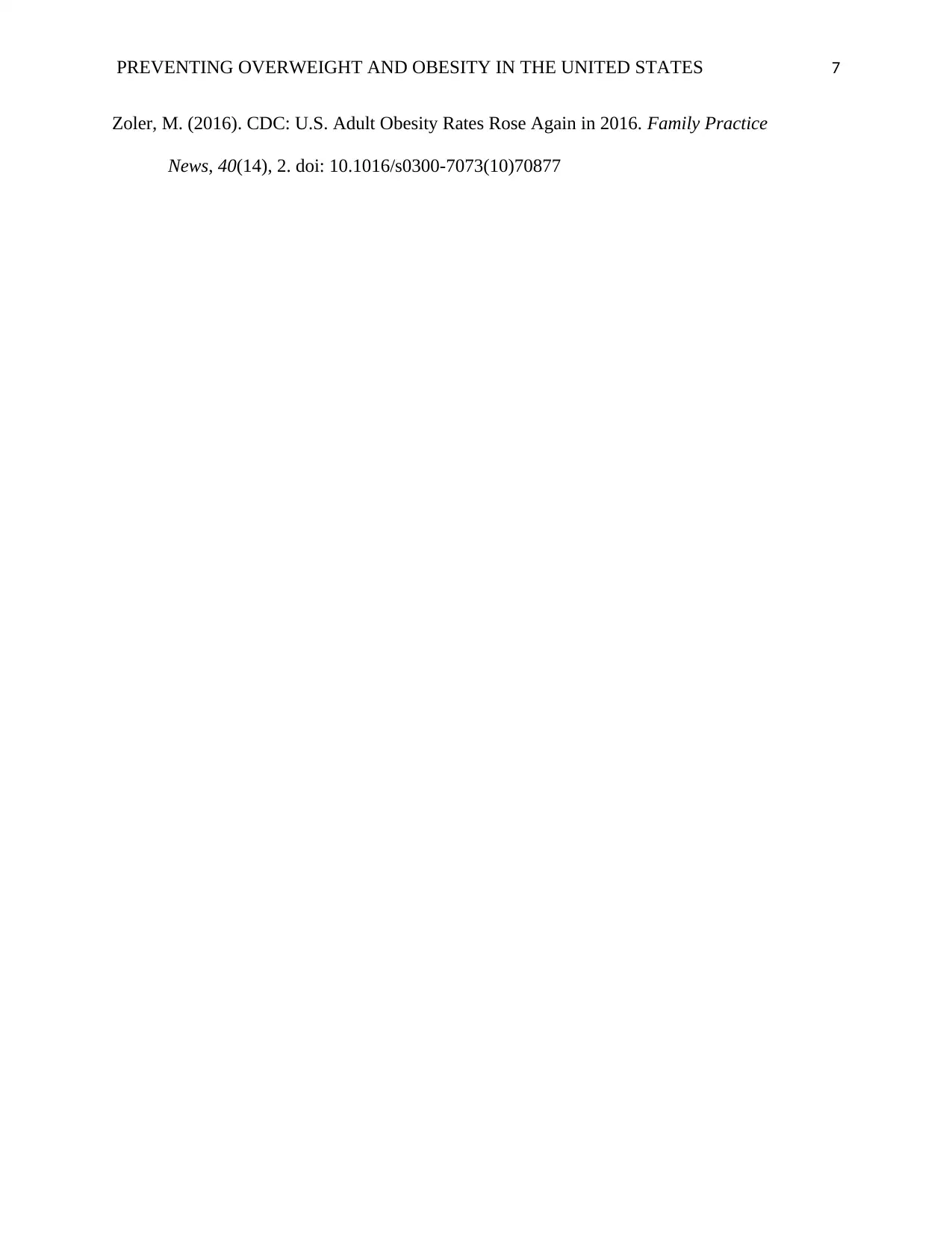
PREVENTING OVERWEIGHT AND OBESITY IN THE UNITED STATES 7
Zoler, M. (2016). CDC: U.S. Adult Obesity Rates Rose Again in 2016. Family Practice
News, 40(14), 2. doi: 10.1016/s0300-7073(10)70877
Zoler, M. (2016). CDC: U.S. Adult Obesity Rates Rose Again in 2016. Family Practice
News, 40(14), 2. doi: 10.1016/s0300-7073(10)70877
1 out of 7
Related Documents
Your All-in-One AI-Powered Toolkit for Academic Success.
+13062052269
info@desklib.com
Available 24*7 on WhatsApp / Email
![[object Object]](/_next/static/media/star-bottom.7253800d.svg)
Unlock your academic potential
Copyright © 2020–2025 A2Z Services. All Rights Reserved. Developed and managed by ZUCOL.




